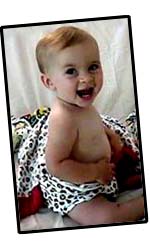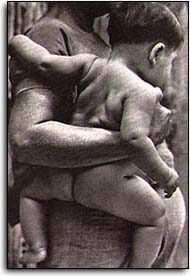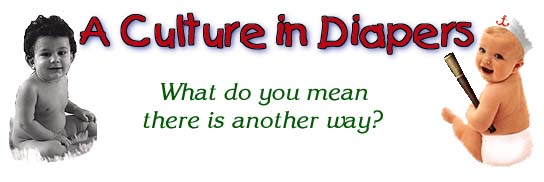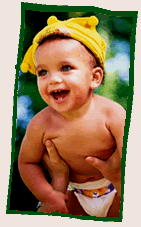Television and magazines are the most common media outlet for diaper ads. These two media are the most effective as images of cute babies appeal to all but the most hard hearted of us. Radio is of course not as effective because images are crucial to the sale of diapers. Magazines such as Good Housekeeping, Martha Stewart's Baby Magazine, Parenting Today, all inevitably feature ads for diapers of all kinds. There are special diapers for newborns, boys, girls, toddlers, night-time, pull-ons for older kids, designer styles, and any number of specialized diapers invented by professional product developers. Articles in magazines by health professionals, and advice columnists offer a variety of opinions on when to toilet train, when not to toilet train, toilet training control issues, and even theories on the negative psychological impact of weaning a baby too early from diapers. There is much diaper paraphernalia such as colour coordinated changing tables, diaper rash creams, special swimming diapers, special disposable wipes for the bottom and many other products to facilitate the diapering routine.

Older children in diapers is considered
weird and dirty in many cultures.
|
The ongoing promotion of diapers does not really have to argue their raison d'Ítre: it's a given that diapering is necessary. However, the promotion continually serves to reinforce the status quo as well as, in the case of ads, to increase demand for diapers by promoting the idea that it is normal for a child to be in diapers at the age of three or four. Images of older children using "Pull-Ups", a term coined by the industry, reinforce the notion that it is acceptable for children not to have learned to go the toilet yet. These campaigns are paid for and presented by the usual corporations such as Pampers,
Huggies and other brands of disposable diapers. In addition, there is a large and growing industry of cloth diapers, patronized by mothers and fathers seeking alternatives to the disposable diaper dilemma, which produces a lot of garbage for our landfills. These parents also want to give their babies natural materials next to their tender skin: unbleached cotton, not tainted with the chemicals and additives found in disposable diapers.  All these advertisement campaigns are indirectly supported by health professionals and hospitals who hand out complimentary products and how-to manuals to the parents at the hospital where their babies are born. The BC Health Guide, sent to every household in the province in 2000, suggests that toilet training should start somewhere between 24 and 30 months (p.221). There is a section on how to deal with diaper rash [p. 228].
LaLeche League International, the breast feeding information and support group for mothers has an extensive section on diapering and toilet training in their book "The Art of Breastfeeding".
All these advertisement campaigns are indirectly supported by health professionals and hospitals who hand out complimentary products and how-to manuals to the parents at the hospital where their babies are born. The BC Health Guide, sent to every household in the province in 2000, suggests that toilet training should start somewhere between 24 and 30 months (p.221). There is a section on how to deal with diaper rash [p. 228].
LaLeche League International, the breast feeding information and support group for mothers has an extensive section on diapering and toilet training in their book "The Art of Breastfeeding".
Universally, all these promotions use cute babies in diapers, showing them as happy and healthy babies. They are invariable adorable, as babies are, and we are touched. Babies are irresistible. They naturally help us to make positive subconscious associations with the product or culture presented. This emotional reaction from consumers works subliminally to associate diapers with all the good, wholesome things in life. The audience being targeted is naturally the diaper consumer, but the effect of this mom-and-apple-pie advertisement is far reaching. All the audience is learning, over and over again, is that diapering is normal and natural. This audience may have babies later, or they may become grandparents, and when they do, they have fairly fixed ideas on diapering from all this promotion.
 The techniques to sell diapers are not complex. Any product that is associated with childhood and the first tender years of babyhood can legitimately use babies in their campaigns. Like women's bodies, the images of healthy cute babies are ubiquitous. Unlike women's bodies which are used to sell all kinds of unrelated products, no one objects to the use of babies in selling baby products. The ads appeal to our hearts through irresistible babies, but they also appeal to our sense of hygiene and cleanliness. Diaper commercials are usually shown against a backdrop of white, which suggests a clinically clean room. There is good reason behind this hygiene message: less than a hundred years ago in North America, babies often died from infections and malnutrition, and cleanliness was instrumental along with nutrition in reducing that mortality rate. However, these otherwise reasonable fears have been hijacked by commercial interests to the point that consumers know no alternative to diapering, thinking it's the only way to be clean and germ-free.
The techniques to sell diapers are not complex. Any product that is associated with childhood and the first tender years of babyhood can legitimately use babies in their campaigns. Like women's bodies, the images of healthy cute babies are ubiquitous. Unlike women's bodies which are used to sell all kinds of unrelated products, no one objects to the use of babies in selling baby products. The ads appeal to our hearts through irresistible babies, but they also appeal to our sense of hygiene and cleanliness. Diaper commercials are usually shown against a backdrop of white, which suggests a clinically clean room. There is good reason behind this hygiene message: less than a hundred years ago in North America, babies often died from infections and malnutrition, and cleanliness was instrumental along with nutrition in reducing that mortality rate. However, these otherwise reasonable fears have been hijacked by commercial interests to the point that consumers know no alternative to diapering, thinking it's the only way to be clean and germ-free.
 If we were to question the need to diaper babies and look around, we might find that there are alternatives. Millions, if not billions, of women around the world, through the ages, have not used diapers. They have not been particularly dirty or diseased as a result. This information is not available to our society because it does not serve the interests of the various industries who rely on the status quo to keep in business. Our source of information is usually advertisements in popular media such as TV and magazines, and clearly they must promote that which will help their industry to survive. Like so many other products that may be redundant if we were to question our day to day habits, diapers might become unnecessary if mothers and fathers were to find out there are alternatives. Where will we get this information? In whose interest is it to promote this alternative? No one has an immediate interest in such a campaign. There are a few voices, but very few. One web site, which promotes the alternative as well as a book, is at http://www.natural-wisdom.com. Infant Potty Training is another web site which shows us how to do it differently.
If we were to question the need to diaper babies and look around, we might find that there are alternatives. Millions, if not billions, of women around the world, through the ages, have not used diapers. They have not been particularly dirty or diseased as a result. This information is not available to our society because it does not serve the interests of the various industries who rely on the status quo to keep in business. Our source of information is usually advertisements in popular media such as TV and magazines, and clearly they must promote that which will help their industry to survive. Like so many other products that may be redundant if we were to question our day to day habits, diapers might become unnecessary if mothers and fathers were to find out there are alternatives. Where will we get this information? In whose interest is it to promote this alternative? No one has an immediate interest in such a campaign. There are a few voices, but very few. One web site, which promotes the alternative as well as a book, is at http://www.natural-wisdom.com. Infant Potty Training is another web site which shows us how to do it differently.
Possibly one day, environmental groups will realise that while using cotton diapers instead of disposable diapers is kinder to the landfills, reducing diaper usage or using no diapers at all means much less energy will be used to wash, dry and produce cloth diapers. Possibly one day, psychologists will prove that early childhood nudity and body function awareness is essential to the high self-esteem and healthy sexuality of the well adjusted adult. Then possibly we can look forward to receiving information that presents us with real choices.




 All these advertisement campaigns are indirectly supported by health professionals and hospitals who hand out complimentary products and how-to manuals to the parents at the hospital where their babies are born. The BC Health Guide, sent to every household in the province in 2000, suggests that toilet training should start somewhere between 24 and 30 months (p.221). There is a section on how to deal with diaper rash [p. 228].
All these advertisement campaigns are indirectly supported by health professionals and hospitals who hand out complimentary products and how-to manuals to the parents at the hospital where their babies are born. The BC Health Guide, sent to every household in the province in 2000, suggests that toilet training should start somewhere between 24 and 30 months (p.221). There is a section on how to deal with diaper rash [p. 228].
 The techniques to sell diapers are not complex. Any product that is associated with childhood and the first tender years of babyhood can legitimately use babies in their campaigns. Like women's bodies, the images of healthy cute babies are ubiquitous. Unlike women's bodies which are used to sell all kinds of unrelated products, no one objects to the use of babies in selling baby products. The ads appeal to our hearts through irresistible babies, but they also appeal to our sense of hygiene and cleanliness. Diaper commercials are usually shown against a backdrop of white, which suggests a clinically clean room. There is good reason behind this hygiene message: less than a hundred years ago in North America, babies often died from infections and malnutrition, and cleanliness was instrumental along with nutrition in reducing that mortality rate. However, these otherwise reasonable fears have been hijacked by commercial interests to the point that consumers know no alternative to diapering, thinking it's the only way to be clean and germ-free.
The techniques to sell diapers are not complex. Any product that is associated with childhood and the first tender years of babyhood can legitimately use babies in their campaigns. Like women's bodies, the images of healthy cute babies are ubiquitous. Unlike women's bodies which are used to sell all kinds of unrelated products, no one objects to the use of babies in selling baby products. The ads appeal to our hearts through irresistible babies, but they also appeal to our sense of hygiene and cleanliness. Diaper commercials are usually shown against a backdrop of white, which suggests a clinically clean room. There is good reason behind this hygiene message: less than a hundred years ago in North America, babies often died from infections and malnutrition, and cleanliness was instrumental along with nutrition in reducing that mortality rate. However, these otherwise reasonable fears have been hijacked by commercial interests to the point that consumers know no alternative to diapering, thinking it's the only way to be clean and germ-free.
 If we were to question the need to diaper babies and look around, we might find that there are alternatives. Millions, if not billions, of women around the world, through the ages, have not used diapers. They have not been particularly dirty or diseased as a result. This information is not available to our society because it does not serve the interests of the various industries who rely on the status quo to keep in business. Our source of information is usually advertisements in popular media such as TV and magazines, and clearly they must promote that which will help their industry to survive. Like so many other products that may be redundant if we were to question our day to day habits, diapers might become unnecessary if mothers and fathers were to find out there are alternatives. Where will we get this information? In whose interest is it to promote this alternative? No one has an immediate interest in such a campaign. There are a few voices, but very few. One web site, which promotes the alternative as well as a book, is at
If we were to question the need to diaper babies and look around, we might find that there are alternatives. Millions, if not billions, of women around the world, through the ages, have not used diapers. They have not been particularly dirty or diseased as a result. This information is not available to our society because it does not serve the interests of the various industries who rely on the status quo to keep in business. Our source of information is usually advertisements in popular media such as TV and magazines, and clearly they must promote that which will help their industry to survive. Like so many other products that may be redundant if we were to question our day to day habits, diapers might become unnecessary if mothers and fathers were to find out there are alternatives. Where will we get this information? In whose interest is it to promote this alternative? No one has an immediate interest in such a campaign. There are a few voices, but very few. One web site, which promotes the alternative as well as a book, is at